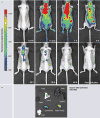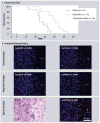Poly(malic acid) nanoconjugates containing various antibodies and oligonucleotides for multitargeting drug delivery
- PMID: 18373429
- PMCID: PMC2734385
- DOI: 10.2217/17435889.3.2.247
Poly(malic acid) nanoconjugates containing various antibodies and oligonucleotides for multitargeting drug delivery
Abstract
Nanoconjugates are emerging as promising drug-delivery vehicles because of their multimodular structure enabling them to actively target discrete cells, pass through biological barriers and simultaneously carry multiple drugs of various chemical nature. Nanoconjugates have matured from simple devices to multifunctional, biodegradable, nontoxic and nonimmunogenic constructs, capable of delivering synergistically functioning drugs in vivo. This review mainly concerns the Polycefin family of natural-derived polymeric drug-delivery devices as an example. This type of vehicle is built by hierarchic conjugation of functional groups onto the backbone of poly(malic acid), an aliphatic polyester obtained from the microorganism Physarum polycephalum. Particular Polycefin variants target human brain and breast tumors implanted into animals specifically and actively and could be detected easily by noninvasive imaging analysis. Delivery of antisense oligonucleotides to a tumor-specific angiogenic marker using Polycefin resulted in significant inhibition of tumor angiogenesis and increase of animal survival.
Figures









References
-
- Zinner RG, Herbst RS. Pemetrexed in the treatment of advanced non-small-cell lung cancer: a review of the clinical data . Clin Lung Cancer. 2004;5 (Suppl 2):S67–S74. - PubMed
-
- Faivre S, Delbaldo C, Vera K, et al. Safety, pharmacokinetic, and antitumor activity of SU11248, a novel oral multitarget tyrosine kinase inhibitor, in patients with cancer. J Clin Oncol. 2006;24:25–35. - PubMed
-
- Konstantinopoulos PA, Vandoros GP, Papavassiliou AG. FK228 (depsipeptide): a HDAC inhibitor with pleiotropic antitumor activities. Cancer Chemother Pharmacol. 2006;58:711–715. - PubMed
-
- Montemurro F, Valabrega G, Aglietta M. Lapatinib: a dual inhibitor of EGFR and HER2 tyrosine kinase activity. Expert Opin Biol Ther. 2007;7:257–268. - PubMed
-
- Maeda H, Wu J, Sawa T, et al. Tumor vascular permeability and the EPR effect in macromolecular therapeutics: a review. J Control Release. 2000;65:271–284. Basic article for understanding the importance of enhanced permeability and retention in drug delivery. - PubMed
Publication types
MeSH terms
Substances
Grants and funding
LinkOut - more resources
Full Text Sources
Other Literature Sources
Medical
